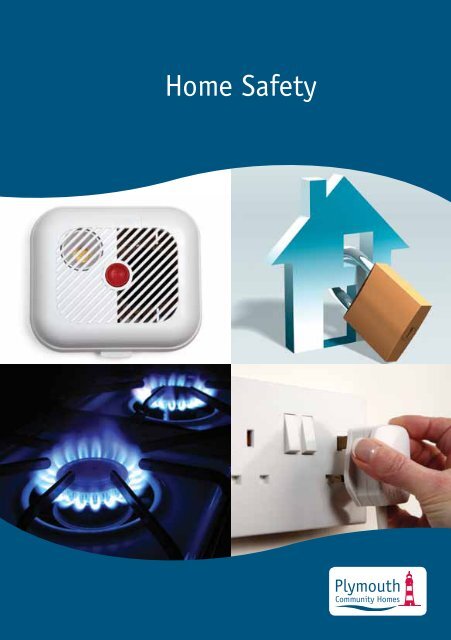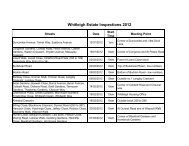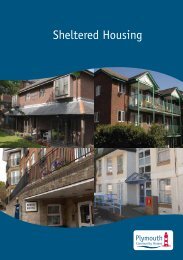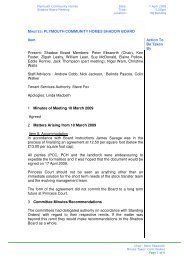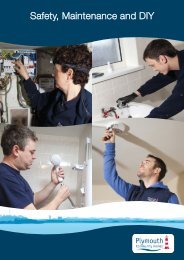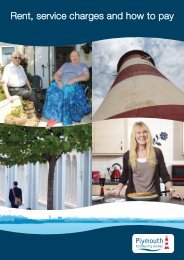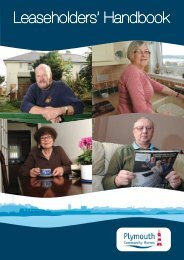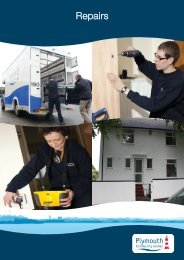Home Safety Leaflet (423.3kb) - Plymouth Community Homes
Home Safety Leaflet (423.3kb) - Plymouth Community Homes
Home Safety Leaflet (423.3kb) - Plymouth Community Homes
Create successful ePaper yourself
Turn your PDF publications into a flip-book with our unique Google optimized e-Paper software.
<strong>Home</strong> <strong>Safety</strong>
Gas safety<br />
The problem<br />
Every year about 30 people<br />
in the UK die from carbon<br />
monoxide poisoning<br />
caused by gas appliances<br />
and flues, which have not<br />
been properly installed or<br />
maintained. Many other<br />
people also suffer ill health.<br />
When gas does not burn<br />
properly, as with other fuels<br />
such as coal, wood or oil,<br />
excess carbon monoxide<br />
is produced, which is<br />
poisonous.<br />
You can’t see it. You can’t<br />
taste it. You can’t even smell<br />
it. But carbon monoxide<br />
can kill without warning in a<br />
matter of hours.<br />
You are particularly at risk<br />
when asleep because<br />
you cannot recognise the<br />
early symptoms of carbon<br />
monoxide poisoning.<br />
These include tiredness,<br />
drowsiness, headache,<br />
nausea, pains in the chest<br />
and stomach pains. These<br />
symptoms may easily be<br />
confused with flu or simple<br />
tiredness.<br />
If you or your family<br />
experience the above<br />
symptoms, and you believe<br />
carbon monoxide may be<br />
involved, you must seek<br />
urgent medical advice.<br />
2
Your doctor will need to test<br />
a blood or breath sample.<br />
Carbon monoxide quickly<br />
leaves the blood and tests<br />
may be inaccurate if taken<br />
more than four hours after<br />
exposure has ended.<br />
You are at risk of carbon<br />
monoxide poisoning if:<br />
• Your appliance was poorly<br />
installed.<br />
• Your appliance is not<br />
working properly.<br />
• Your appliance has not<br />
been checked for safety<br />
or maintained regularly.<br />
• There is not enough fresh<br />
air in the room.<br />
• Your chimney or flue gets<br />
blocked up.<br />
• You allow non-Gas Saferegistered<br />
engineers to<br />
install or maintain your<br />
appliance(s).<br />
A safe gas appliance<br />
There is a particular risk if<br />
you sleep in a room where<br />
an appliance, which is not of<br />
the room-sealed type (e.g. a<br />
conventional gas fire), is left<br />
burning at night.<br />
(Flue outlets for room-sealed<br />
appliances are commonly<br />
located on an external wall<br />
at a low level protected by a<br />
cage, rather than at or above<br />
roof level).<br />
The answers<br />
NEVER use a gas appliance<br />
if you think it is not working<br />
properly.<br />
Signs to look out for include<br />
yellow or orange flames<br />
(except fuel-effect fires which<br />
display this colour flame),<br />
soot or stains around the<br />
appliance and pilot lights<br />
which frequently blow out.<br />
NEVER cover an appliance<br />
or block the conventional air<br />
vents.<br />
NEVER block or obstruct<br />
any fixed ventilation grilles or<br />
air bricks.<br />
CAUTION: Whenever<br />
draught exclusion, ceiling<br />
or extraction fans, double<br />
glazing or conservatory<br />
extensions are fitted to<br />
a room containing a gas<br />
appliance, the appliance<br />
should subsequently be<br />
checked for safety.<br />
3
4<br />
ALL gas consumers must<br />
have appliances checked<br />
for safety and serviced at<br />
least every 12 months by a<br />
Gas Safe-registered service<br />
engineer.<br />
Carbon monoxide alarms are<br />
a useful back-up precaution<br />
but must NOT be regarded<br />
as a substitute for proper<br />
installation and maintenance<br />
of gas equipment by a Gas<br />
Safe-registered installer. If<br />
you decide to buy a carbon<br />
monoxide alarm, ensure<br />
it meets current safety<br />
standards (BS 7860 or<br />
BS EN 50291) and carries<br />
the Kitemark. If in doubt<br />
ask a member of staff<br />
for advice. Always follow<br />
the manufacturer’s siting<br />
instructions.<br />
Gas leaks<br />
If you smell gas, or suspect<br />
there is a gas escape, you<br />
should immediately:<br />
• Open all doors and<br />
windows.<br />
• Shut off the gas supply<br />
at the meter control valve<br />
(if you know where it is).<br />
If gas continues to escape<br />
call Wales and West<br />
Utilities on the Gas<br />
Emergency Freephone<br />
Number 0800 111 999.<br />
• In the case of suspected<br />
carbon monoxide<br />
leakage, follow the above<br />
procedure, except if<br />
you are able to identify<br />
the specific appliance<br />
at fault. In this case you<br />
should consult a Gas<br />
Safe-registered installer<br />
to investigate and make<br />
repairs.<br />
The law<br />
The Gas <strong>Safety</strong> (installation<br />
and use) Regulations,<br />
1998 places duties on<br />
gas consumers, installers,<br />
suppliers and landlords.<br />
These regulations are linked<br />
to other safety controls on<br />
combustion equipment,<br />
e.g. the Building Regulations,<br />
which set the safety<br />
standards for ventilation<br />
and flues.<br />
For your own protection<br />
remember:<br />
• By law, anyone<br />
carrying out work on<br />
gas appliances or<br />
fittings as part of their<br />
business must be
competent and<br />
registered with Gas<br />
Safe. Always ask to see<br />
your installer’s current Gas<br />
Safe photo ID card which<br />
has their photograph, Gas<br />
Safe registration number,<br />
trading title and the<br />
expiry date of the card.<br />
The reverse of the card<br />
details what kind of gas<br />
work the installer is able<br />
to do. You can also call<br />
Gas Safe during normal<br />
office hours on 0800 408<br />
5500 or log on to the Gas<br />
Safe website on www.<br />
gassaferegister.co.uk.<br />
Gas service engineers<br />
working on behalf of<br />
<strong>Plymouth</strong> <strong>Community</strong><br />
<strong>Home</strong>s have an ID card<br />
confirming their identity.<br />
• By law only a<br />
competent person can<br />
carry out work on gas<br />
appliances or fittings.<br />
Do-it-yourself work on<br />
gas appliances or fittings<br />
could be dangerous and<br />
is likely to be illegal.<br />
• By law you must not<br />
use any gas appliance<br />
or fittings you know or<br />
suspect to be unsafe.<br />
Through Gas Safe,<br />
the Health and <strong>Safety</strong><br />
Executive has asked<br />
all registered installers<br />
to disconnect any gas<br />
appliance or fittings,<br />
which are so dangerous<br />
as to be a threat to life<br />
if used. If your installer<br />
asks your permission<br />
to disconnect such an<br />
appliance or fitting it will<br />
be in yours and others<br />
own interests, to agree.<br />
Before you use this<br />
appliance or fitting again,<br />
have it repaired by a Gas<br />
Safe-registered installer.<br />
• By law, landlords are<br />
generally responsible<br />
for making sure that<br />
gas fittings and flues<br />
are maintained in<br />
good order and gas<br />
appliances and flues<br />
are checked for safety<br />
once every 12 months.<br />
They must also keep<br />
a record of the safety<br />
checks for at least<br />
two years and issue<br />
the latest certificate to<br />
existing tenants and<br />
any new tenants before<br />
they move in.<br />
5
If you own the appliance,<br />
you are responsible for<br />
its maintenance and<br />
safety checks. However,<br />
if you are a <strong>Plymouth</strong><br />
<strong>Community</strong> <strong>Home</strong>s’<br />
tenant, we will service<br />
these appliances, but you<br />
must let us know that you<br />
have installed them.<br />
• By law, with the<br />
exception of the<br />
room-sealed type,<br />
there are restrictions<br />
on the installation of<br />
gas appliances such<br />
as fires, boilers and<br />
heaters in sleeping<br />
accommodation. These<br />
restrictions apply only<br />
to appliances fitted<br />
after 1st January 1996,<br />
and to those already<br />
installed in rooms in<br />
rented accommodation<br />
which have been<br />
converted to bedrooms<br />
after 31st October<br />
1998. Appliances, which<br />
are not room-sealed,<br />
(e.g. conventional gas<br />
fires of 14 kilowatts or<br />
less), may only be fitted if<br />
they have a device which<br />
automatically turns the<br />
gas supply off before a<br />
dangerous level of fumes<br />
can build up.<br />
6
However, for appliances<br />
above 14 kilowatts, only<br />
those of a room-sealed<br />
type are allowed in such<br />
accommodation.<br />
• By law, since 31st<br />
October 1998, it<br />
has been illegal to<br />
install, in any room,<br />
instantaneous water<br />
heaters which are not<br />
room-sealed or fitted<br />
with a safety device<br />
which automatically<br />
turns the gas supply<br />
off before a dangerous<br />
level of poisonous<br />
fumes can build up.<br />
• By law, mains<br />
gas transporters/<br />
emergency service<br />
providers (ESPs) must,<br />
in the event of an<br />
emergency, make the<br />
situation safe. They<br />
should establish the<br />
cause of a gas escape<br />
within two hours. In<br />
the case of actual or<br />
suspected escapes of<br />
carbon monoxide they<br />
must respond to reports<br />
from consumers and<br />
make the situation safe.<br />
Getting your gas<br />
appliances serviced<br />
If you have gas appliances<br />
in your property, we will<br />
contact you every year, to<br />
let you know when they<br />
are due for servicing and<br />
arrange an appointment.<br />
The appointment will be in<br />
the morning or afternoon.<br />
If the appointment time is<br />
inconvenient, you should<br />
arrange another time, using<br />
the telephone number<br />
provided.<br />
Morning appointments are<br />
between 8am and 1pm.<br />
Afternoon appointments are<br />
between 1pm and 5pm.<br />
If you have arranged for gas<br />
appliances to be installed,<br />
you must let us know, so<br />
that we have an accurate<br />
record of appliances in our<br />
homes. We will also service<br />
these appliances.<br />
You will be sent a customer<br />
satisfaction form which<br />
we ask you to complete<br />
and return (a postage-paid<br />
envelope will be included)<br />
after servicing has been<br />
carried out. We value your<br />
comments and the<br />
7
information you provide<br />
will be used to assist us in<br />
improving the service.<br />
It is your responsibility<br />
to provide access to the<br />
property to allow gas<br />
appliances to be serviced.<br />
If you miss an appointment<br />
to have appliances serviced,<br />
it is very important that you<br />
contact us to re-arrange a<br />
suitable time by:<br />
Telephone:<br />
08082 306500<br />
Emailing via:<br />
www.plymouthcommunity<br />
homes.co.uk<br />
Writing to:<br />
The Gas Servicing Team<br />
<strong>Plymouth</strong> <strong>Community</strong> <strong>Home</strong>s<br />
Prince Rock Depot<br />
Macadam Road<br />
<strong>Plymouth</strong><br />
PL4 0RZ<br />
We will continue to try and<br />
gain access to your property<br />
until appliances have been<br />
serviced, so please do not<br />
ignore our letters.<br />
If you refuse us access,<br />
we will take legal action to<br />
obtain access to service<br />
the gas appliances, which<br />
may result in your eviction<br />
for failing to comply with<br />
your Tenancy Agreement.<br />
If <strong>Plymouth</strong> <strong>Community</strong><br />
<strong>Home</strong>s takes legal action<br />
you will be liable to pay<br />
legal costs. We will give<br />
you warning if we are<br />
going to do this.<br />
• It is your responsibility to provide access to the<br />
property to allow gas appliances to be serviced.<br />
• If you refuse us access, we will take legal action to<br />
obtain access to service the gas appliances.<br />
• If we take legal action, you will be liable to pay<br />
legal costs.<br />
8
Electrical <strong>Safety</strong><br />
Get permission first<br />
If you want to fit fixed<br />
electrical equipment inside<br />
or outside your property, you<br />
must get permission from<br />
your local housing office,<br />
under the terms of your<br />
Tenancy Agreement.<br />
All works must be completed,<br />
inspected, tested and<br />
certified by the equivalent of<br />
a National Inspection Council<br />
for Electrical Installation<br />
Contractors (NICEIC)<br />
approved contractor. Copies<br />
of the test certificate for the<br />
completed works must be<br />
supplied to your housing<br />
officer.<br />
You must get permission<br />
before you install:<br />
• Security or other additional<br />
external lighting.<br />
• Additional socket outlets.<br />
• Any internal lighting and/<br />
or switches.<br />
• Showers.<br />
• Supplies to outbuildings.<br />
• Electrically powered<br />
garden features, e.g.<br />
water pumps, (pools<br />
which also require<br />
permission) as electrical,<br />
gas or water services may<br />
be present.<br />
Before plugging in electrical<br />
tools and equipment<br />
especially when outside,<br />
always:<br />
3 Use a Residual Current<br />
Device (RCD) and<br />
test it before use. This<br />
automatically switches off<br />
the electricity supply to<br />
the equipment if there is<br />
an earth fault. If the RCD<br />
does not work and is part<br />
of the fixed supply, do not<br />
use electrical equipment<br />
and report the fault to<br />
Repairs. RCD devices can<br />
also be purchased from<br />
good DIY stores.<br />
3 Check that the electrical<br />
equipment – plugs,<br />
sockets, cables, leads –<br />
are not worn.<br />
3 Buy good quality electrical<br />
equipment from a<br />
reputable manufacturer<br />
(look for the<br />
BEAB label<br />
or Kitemark<br />
safety symbol).<br />
9
3 Lay out the leads or<br />
cable so that they do not<br />
become damaged or a<br />
trip hazard.<br />
3 Wear protective clothing<br />
and footwear, particularly<br />
in damp conditions.<br />
3 Follow the manufacturers’<br />
instructions.<br />
3 Uncoil extension leads to<br />
prevent overheating.<br />
3 When finished, store<br />
electrical equipment in a<br />
dry place and out of reach<br />
of children.<br />
For your safety, DO NOT<br />
8 Clean, adjust or check<br />
equipment when it<br />
is connected to the<br />
electricity supply.<br />
8 Attempt to repair electrical<br />
equipment or electrical<br />
installations unless you<br />
are qualified to do so.<br />
8 Wash equipment when it is<br />
plugged in. Always unplug<br />
it and use a dry cloth.<br />
8 Use electrical equipment<br />
when barefoot or wearing<br />
sandals.<br />
8 Leave plugged in electrical<br />
equipment unattended.<br />
8 Work on metal steps<br />
or ladders when using<br />
electrical equipment.<br />
8 Leave trailing cables<br />
where they could be a<br />
hazard to others (e.g.<br />
communal areas or<br />
stairwells) or across sinks<br />
or puddles.<br />
If in any doubt, call <strong>Plymouth</strong><br />
<strong>Community</strong> <strong>Home</strong>s’<br />
Electrical Servicing Section<br />
on 08082 306500.<br />
Asbestos in your home<br />
Facts about asbestos –<br />
where it may have been<br />
used and what to do if<br />
you find it in your home.<br />
We gratefully acknowledge<br />
that this information is based<br />
upon the booklet Asbestos<br />
in the <strong>Home</strong>, published by<br />
the former Department of<br />
Environment, Transport and<br />
the Regions (DETR) in 1999.<br />
10
Introduction<br />
This information addresses<br />
concerns and questions<br />
about asbestos in homes.<br />
It explains what it is, where<br />
it is found, why it might be<br />
a problem, and how to deal<br />
with it.<br />
Asbestos fibres are strong<br />
and resistant to heat and<br />
chemicals. This has led<br />
to their use in a wide<br />
range of building materials<br />
and products, often as<br />
fireproofing.<br />
Properties built since the<br />
mid 1980s are very unlikely<br />
to contain asbestos in<br />
the fabric of the building.<br />
Properties built after 1990<br />
are extremely unlikely to<br />
contain asbestos anywhere<br />
in the building. Asbestos<br />
cement has been widely<br />
used as a cladding material<br />
and can still be found in<br />
garages and sheds.<br />
Why may asbestos be a<br />
problem?<br />
When asbestos materials<br />
age or become damaged<br />
they can release fibres<br />
into the air. These can be<br />
breathed deep into the lung<br />
where they may stay for a<br />
long time, causing possible<br />
damage. When very high<br />
levels of these fibres are<br />
breathed in, there is a risk<br />
of lung diseases, including<br />
cancer.<br />
People who have worked<br />
with asbestos for many<br />
years as part of their job,<br />
or have washed the dusty<br />
clothing of those who have<br />
worked with asbestos are<br />
most likely to be affected.<br />
Workplace regulations now<br />
protect such people.<br />
Is everyone exposed to<br />
asbestos?<br />
There is a low level of<br />
fibres in the air everywhere<br />
because asbestos has been<br />
used widely. Exposure to this<br />
low level of fibres is unlikely<br />
to harm people’s health.<br />
Levels of fibres may be<br />
higher in buildings containing<br />
asbestos materials,<br />
especially where the<br />
materials are damaged. It is<br />
very unlikely that the levels<br />
of asbestos fibres found<br />
in buildings will be harmful<br />
but if you have damaged<br />
asbestos materials in your<br />
11
home you should seek<br />
advice on the appropriate<br />
action to take.<br />
High, short-term exposure<br />
to asbestos fibres can occur<br />
during DIY work. For this<br />
reason, try not to raise dust<br />
and avoid sanding or drilling<br />
when working with materials<br />
which might contain<br />
asbestos.<br />
Where is asbestos found?<br />
Building materials containing<br />
asbestos were widely used<br />
from 1930 to around 1980,<br />
particularly from the 1960s<br />
onwards. Houses and flats<br />
built or refurbished at this<br />
time may contain asbestos<br />
materials.<br />
Asbestos has also been<br />
used in some heat-resistant<br />
household products, such<br />
as oven gloves and ironing<br />
boards. The use of asbestos<br />
in these products decreased<br />
greatly around the mid<br />
1980s, and since 1993 the<br />
use of asbestos in most of<br />
these products has been<br />
banned.<br />
It is not always easy to<br />
tell whether a product<br />
contains asbestos – modern<br />
asbestos-free materials often<br />
look similar. Remember it is<br />
usually older products that<br />
contain asbestos.<br />
Loft or cavity wall insulation<br />
does not contain asbestos.<br />
• Try not to raise dust and avoid sanding or drilling when<br />
working with materials that might contain asbestos.<br />
• Loft or cavity wall insulation does not contain asbestos.<br />
• The types of asbestos materials that may be found in<br />
homes includes: insulating board, asbestos lagging,<br />
sprayed coating, asbestos-cement products, other<br />
building materials and products and in heating<br />
appliances and domestic equipment.<br />
12
These are the type of<br />
asbestos materials that may<br />
be found in homes:<br />
• Insulating board<br />
(Asbestos content<br />
20-45%)<br />
Insulating board is used<br />
for fire protection, heat<br />
and sound insulation. It<br />
is particularly common in<br />
1960s and 1970s systembuilt<br />
housing and is found<br />
in materials such as<br />
ducts, infill panels, ceiling<br />
tiles, wall lining, bath<br />
panels and partitions. It<br />
is unlikely to be found<br />
in buildings constructed<br />
after 1982.<br />
• Asbestos lagging<br />
(Asbestos content<br />
55-100%)<br />
Asbestos lagging has<br />
been used for thermal<br />
insulation of pipes and<br />
boilers. It was widely<br />
used in public buildings<br />
and system-built flats<br />
during the 1960s to early<br />
1970s, in areas such as<br />
boiler houses and heating<br />
plants. Asbestos lagging<br />
is very rarely found in<br />
homes, especially those<br />
constructed after the<br />
mid 1970s. The use of<br />
asbestos for thermal<br />
insulation was banned<br />
in 1986.<br />
• Sprayed coating<br />
(Asbestos content<br />
up to 85%)<br />
Sprayed asbestos<br />
coatings were used for<br />
fire protection of structural<br />
steel and are commonly<br />
found in system-built flats<br />
built during the 1960s.<br />
The coatings were mainly<br />
applied around the core<br />
of the building such as<br />
service ducts, lift shafts,<br />
etc. This stopped in<br />
1974 and the spraying<br />
of asbestos has been<br />
banned since 1986.<br />
Sprayed asbestos has<br />
since been removed from<br />
many buildings or sealed<br />
to prevent fibres being<br />
released.<br />
• Asbestos-cement<br />
products<br />
(Asbestos content mainly<br />
10-15%, but sometimes<br />
up to 40%)<br />
Asbestos-cement is<br />
the most widely used<br />
asbestos material. It is<br />
found in many types of<br />
13
uilding – profiled sheets<br />
for roofing and wallcladding;<br />
flat sheets and<br />
partition boards for linings<br />
to walls and ceilings; bath<br />
panels, soffit boards, fire<br />
surrounds, flue pipes,<br />
cold water tanks; and<br />
roofing tiles and slates. It<br />
has been commonly used<br />
as roofing and cladding<br />
for garages and sheds<br />
and also in guttering and<br />
drainpipes. Its use has<br />
declined since 1976 but<br />
asbestos-cement is still<br />
being used, particularly<br />
in roofing and cladding<br />
products. Asbestoscement<br />
products are<br />
unlikely to release high<br />
levels of fibres because of<br />
the way they are made,<br />
unless they are subject<br />
to extreme abrasion.<br />
Damage from weathering<br />
may also release a small<br />
amount of fibres.<br />
• Other building<br />
materials and products<br />
Asbestos has been<br />
used in a variety of other<br />
building materials, for<br />
example, in decorative<br />
coatings such as textured<br />
paint, plasters and artex.<br />
These are still widely in<br />
place but supply and<br />
application has been<br />
prohibited since 1988.<br />
Plastic floor tiles, cushion<br />
flooring, roofing felts,<br />
tapes, ropes, felts and<br />
blankets can also contain<br />
asbestos.<br />
• Heating appliances and<br />
domestic equipment<br />
Asbestos was used in<br />
some warm air heating<br />
systems, electric storage<br />
heaters up to 1976, in<br />
flameless catalytic gas<br />
heaters up to 1988 and<br />
some early ‘coal effect’<br />
gas fires. Asbestos<br />
has also been used in<br />
domestic equipment,<br />
such as oven gloves,<br />
ironing boards, seals on<br />
cooker doors and fire<br />
blankets and in brake<br />
linings and pads.<br />
How can I identify<br />
products or materials<br />
containing asbestos?<br />
Since 1976 British<br />
manufacturers have put<br />
labels on their products to<br />
show they contain asbestos<br />
14
and since 1986 all products<br />
containing asbestos carry<br />
the European label.<br />
The supplier or manufacturer<br />
of a product may be able<br />
to tell you if it contains<br />
asbestos.<br />
Often homes built at the<br />
same time contain similar<br />
materials – your neighbours<br />
may know if surveys for<br />
asbestos have been done.<br />
<strong>Plymouth</strong> City Council’s<br />
Environmental Protection<br />
Section may be able to help<br />
identify if you have asbestos<br />
products in your home or<br />
if homes in your area have<br />
been surveyed.<br />
Remember, asbestos<br />
containing products can<br />
look very similar to those<br />
not containing asbestos –<br />
if in doubt SEEK ADVICE.<br />
What should I do if I<br />
suspect there is asbestos<br />
in my home?<br />
• Asbestos materials which<br />
are in good condition<br />
and cannot readily be<br />
damaged, are often<br />
best left where they are<br />
because removal can lead<br />
to higher levels of fibres<br />
in the air for some time.<br />
Check the condition of<br />
15
16<br />
asbestos materials from<br />
time to time to make sure<br />
they have not become<br />
damaged or started to<br />
deteriorate.<br />
If you are planning<br />
home improvements or<br />
maintenance and have<br />
asbestos in your home,<br />
always inform builders,<br />
maintenance workers or<br />
contractors before they<br />
start work.<br />
• Asbestos materials that<br />
are slightly damaged can<br />
sometimes be repaired by<br />
sealing or enclosing the<br />
material – SEEK ADVICE<br />
on the most appropriate<br />
action.<br />
• Asbestos materials that<br />
are badly damaged or<br />
deteriorating can release<br />
dust and should be<br />
removed. Some asbestos<br />
materials (sprayed<br />
asbestos, lagging or<br />
insulating boards) must<br />
always be removed<br />
by contractors with a<br />
special license issued by<br />
the Government. These<br />
licensed contractors have<br />
to follow regulations to<br />
ensure asbestos is safely<br />
removed. Your local<br />
environmental health<br />
officer should be able to<br />
provide advice on<br />
asbestos removal and<br />
licensed contractors.<br />
Sometimes it is<br />
dangerous to have<br />
asbestos removed – for<br />
instance fire-protection<br />
materials – without<br />
replacing it with a suitable<br />
alternative.<br />
• Prior to undertaking<br />
alterations to structure,<br />
fixtures and fittings, a<br />
<strong>Plymouth</strong> <strong>Community</strong><br />
<strong>Home</strong>s’ tenant must<br />
receive written permission<br />
from us.<br />
Take care when doing DIY<br />
If you have asbestos<br />
materials in your home, extra<br />
care should be taken in<br />
DIY. DO NOT attempt work<br />
involving sprayed asbestos,<br />
lagging or insulating boards.<br />
This must be undertaken by<br />
a licensed asbestos removal<br />
contractor. If in doubt, SEEK<br />
ADVICE.
If you do any DIY with<br />
asbestos materials, take the<br />
following precautions:<br />
• Keep other people away<br />
from the area of work.<br />
• Wear protective clothing<br />
(e.g. disposable overalls),<br />
and avoid breathing<br />
in asbestos dust (a<br />
disposable dust mask<br />
‘CE’ marked to EN 149<br />
with FFP3 particulate<br />
filters is recommended).<br />
• Keep asbestos materials<br />
wet to avoid producing<br />
dust.<br />
• Work outside if possible<br />
and avoid working<br />
overhead.<br />
• Do not drill, cut or<br />
disturb asbestos unless<br />
absolutely necessary.<br />
• Do not scrape or sand<br />
asbestos materials before<br />
painting and decorating.<br />
Some types of asbestos<br />
materials are very soft and<br />
can release large numbers<br />
of fibres if rubbed or<br />
scraped.<br />
• Use hand tools rather<br />
than power tools.<br />
• Do not use a domestic<br />
vacuum cleaner to clear<br />
up the dust. Hire an<br />
industrial vacuum cleaner<br />
that conforms to BS 5415<br />
(Type H).<br />
• When you have finished<br />
work, clean up and then<br />
carefully take off your<br />
overalls to avoid raising<br />
any dust which may have<br />
collected in the fabric.<br />
In the case of disposable<br />
overalls, double-bag them,<br />
clearly mark ASBESTOS on<br />
the bag and dispose of them<br />
as asbestos waste.<br />
REMEMBER:<br />
• Avoid disturbing or<br />
damaging asbestos<br />
materials in good<br />
condition.<br />
• If you have damaged or<br />
deteriorating asbestos<br />
materials in your home<br />
then SEEK ADVICE.<br />
• Do not keep using oven<br />
gloves or other small<br />
items containing<br />
asbestos – dispose of<br />
them safely (see section<br />
on disposal of asbestos).<br />
17
• If you think that your<br />
warm air heating system,<br />
electrical storage heating<br />
system or flameless<br />
catalytic gas heater,<br />
may contain asbestos<br />
SEEK ADVICE from your<br />
local gas or electricity<br />
supplier. If they do<br />
contain asbestos, do<br />
not attempt to dismantle<br />
these appliances yourself,<br />
but SEEK ADVICE from<br />
<strong>Plymouth</strong> <strong>Community</strong><br />
<strong>Home</strong>s.<br />
How should I dispose of<br />
asbestos?<br />
Wet small amounts of<br />
asbestos waste and put it in<br />
a strong plastic bag – seal<br />
this tightly and clearly mark it<br />
ASBESTOS.<br />
Do not break up large<br />
asbestos-cement sheets –<br />
they do not need to be<br />
sealed in bags but should<br />
be wrapped in polythene<br />
or similar sheeting and<br />
disposed of as asbestos<br />
waste.<br />
18
Do not put asbestos waste<br />
in the dustbin – SEEK<br />
ADVICE from <strong>Plymouth</strong><br />
<strong>Community</strong> <strong>Home</strong>s about<br />
how to dispose of your<br />
asbestos waste.<br />
REMEMBER:<br />
• Avoid creating asbestos<br />
dust.<br />
• Avoid breathing asbestos<br />
dust.<br />
• Asbestos material in<br />
good condition should<br />
be left alone.<br />
• If you think you may have<br />
asbestos containing<br />
products in your house,<br />
SEEK ADVICE from<br />
<strong>Plymouth</strong> <strong>Community</strong><br />
<strong>Home</strong>s before you take<br />
any action.<br />
Owner-occupiers or<br />
tenants renting from a<br />
private landlord or housing<br />
association should contact,<br />
<strong>Plymouth</strong> City Council’s<br />
Environmental Protection<br />
Section.<br />
For asbestos collections<br />
contact <strong>Plymouth</strong> City<br />
Council’s Waste and Street<br />
Services for advice.<br />
Advice from <strong>Plymouth</strong><br />
<strong>Community</strong> <strong>Home</strong>s<br />
If you live in a <strong>Plymouth</strong><br />
<strong>Community</strong> <strong>Home</strong>s’ home<br />
and want more advice or<br />
information on asbestos in<br />
your home, please contact<br />
the Asbestos Team, Housing<br />
and Development.<br />
19
<strong>Plymouth</strong> <strong>Community</strong> <strong>Home</strong>s Limited<br />
Princess Court, 23 Princess Street,<br />
<strong>Plymouth</strong> PL1 2EX.<br />
0800 694 3101<br />
www.plymouthcommunityhomes.co.uk<br />
REPAIRS FREEPHONE 08082 306500<br />
A charitable Industrial and Provident Society • Registered Number 30637R


